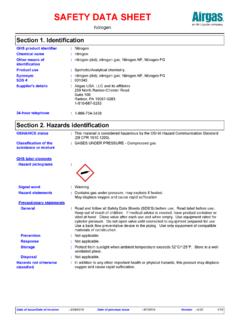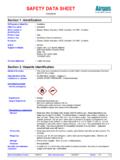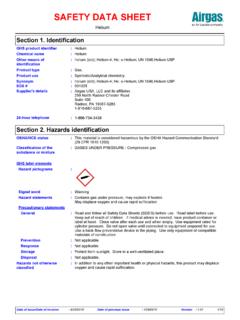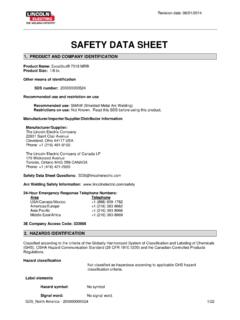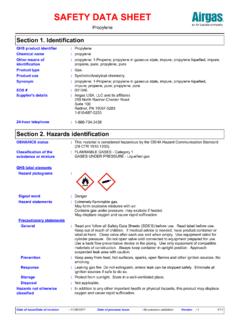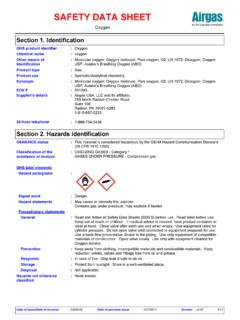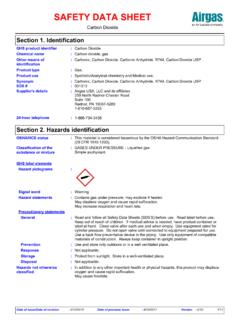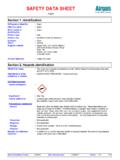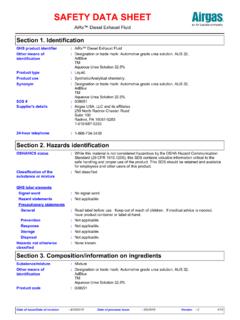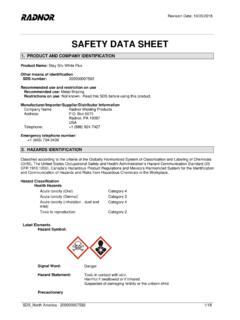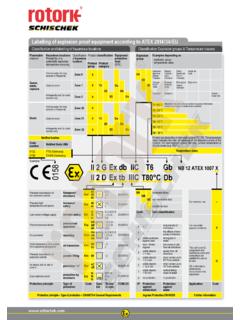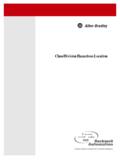Transcription of SAFETY DATA SHEET - Airgas
1 SAFETY data SHEET . Acetylene Section 1. Identification GHS product identifier : Acetylene Chemical name : acetylene Other means of : Ethyne; Ethine; Narcylen; C2H2; Acetylen; UN 1001; Vinylene identification Product type : Gas. Product use : Synthetic/Analytical chemistry. Synonym : Ethyne; Ethine; Narcylen; C2H2; Acetylen; UN 1001; Vinylene SDS # : 001001. Supplier's details : Airgas USA, LLC and its affiliates 259 North Radnor-Chester Road Suite 100. Radnor, PA 19087-5283. 1-610-687-5253. 24-hour telephone : 1-866-734-3438.
2 Section 2. Hazards identification OSHA/HCS status : This material is considered hazardous by the OSHA Hazard Communication Standard (29 CFR ). Classification of the : FLAMMABLE GASES - Category 1. substance or mixture GASES UNDER pressure - Compressed gas GHS label elements Hazard pictograms : Signal word : Danger Hazard statements : Extremely flammable gas. May form explosive mixtures with air. Contains gas under pressure ; may explode if heated. May displace oxygen and cause rapid suffocation. Precautionary statements General : Read and follow all SAFETY data Sheets (SDS'S) before use.
3 Read label before use. Keep out of reach of children. If medical advice is needed, have product container or label at hand. Close valve after each use and when empty. Use equipment rated for cylinder pressure . Do not open valve until connected to equipment prepared for use. Fusible plugs in top, bottom, or valve melt at 98 C to 107 C (208 F to 224 F). Do not discharge at pressures above 15psig (103kpa). Use a back flow preventative device in the piping. Use only equipment of compatible materials of construction. Approach suspected leak area with caution.
4 Prevention : Keep away from heat, hot surfaces, sparks, open flames and other ignition sources. No smoking. Response : Leaking gas fire: Do not extinguish, unless leak can be stopped safely. Eliminate all ignition sources if safe to do so. Storage : Protect from sunlight. Store in a well-ventilated place. Disposal : Not applicable. Hazards not otherwise : In addition to any other important health or physical hazards, this product may displace classified oxygen and cause rapid suffocation. Date of issue/Date of revision : 1/18/2018 Date of previous issue : 10/10/2017 Version : 1/11.
5 Acetylene Section 3. Composition/information on ingredients Substance/mixture : Substance Chemical name : acetylene Other means of : Ethyne; Ethine; Narcylen; C2H2; Acetylen; UN 1001; Vinylene identification Product code : 001001. CAS number/other identifiers CAS number : 74-86-2. Ingredient name % CAS number acetylene 100 74-86-2. Any concentration shown as a range is to protect confidentiality or is due to batch variation. There are no additional ingredients present which, within the current knowledge of the supplier and in the concentrations applicable, are classified as hazardous to health or the environment and hence require reporting in this section.
6 Occupational exposure limits, if available, are listed in Section 8. Section 4. First aid measures Description of necessary first aid measures Eye contact : Immediately flush eyes with plenty of water, occasionally lifting the upper and lower eyelids. Check for and remove any contact lenses. Continue to rinse for at least 10. minutes. Get medical attention if irritation occurs. Inhalation : Remove victim to fresh air and keep at rest in a position comfortable for breathing. If not breathing, if breathing is irregular or if respiratory arrest occurs, provide artificial respiration or oxygen by trained personnel.
7 It may be dangerous to the person providing aid to give mouth-to-mouth resuscitation. Get medical attention if adverse health effects persist or are severe. If unconscious, place in recovery position and get medical attention immediately. Maintain an open airway. Loosen tight clothing such as a collar, tie, belt or waistband. Skin contact : Flush contaminated skin with plenty of water. Remove contaminated clothing and shoes. To avoid the risk of static discharges and gas ignition, soak contaminated clothing thoroughly with water before removing it.
8 Get medical attention if symptoms occur. Wash clothing before reuse. Clean shoes thoroughly before reuse. Ingestion : As this product is a gas, refer to the inhalation section. Most important symptoms/effects, acute and delayed Potential acute health effects Eye contact : Contact with rapidly expanding gas may cause burns or frostbite. Inhalation : No known significant effects or critical hazards. Skin contact : Contact with rapidly expanding gas may cause burns or frostbite. Frostbite : Try to warm up the frozen tissues and seek medical attention.
9 Ingestion : As this product is a gas, refer to the inhalation section. Over-exposure signs/symptoms Eye contact : No specific data . Inhalation : No specific data . Skin contact : No specific data . Ingestion : No specific data . Indication of immediate medical attention and special treatment needed, if necessary Notes to physician : Treat symptomatically. Contact poison treatment specialist immediately if large quantities have been ingested or inhaled. Specific treatments : No specific treatment. Date of issue/Date of revision : 1/18/2018 Date of previous issue : 10/10/2017 Version : 2/11.
10 Acetylene Section 4. First aid measures Protection of first-aiders : No action shall be taken involving any personal risk or without suitable training. It may be dangerous to the person providing aid to give mouth-to-mouth resuscitation. See toxicological information (Section 11). Section 5. Fire-fighting measures Extinguishing media Suitable extinguishing : Use an extinguishing agent suitable for the surrounding fire. media Unsuitable extinguishing : None known. media Specific hazards arising : Contains gas under pressure . Extremely flammable gas.
